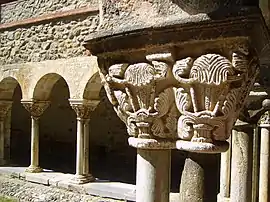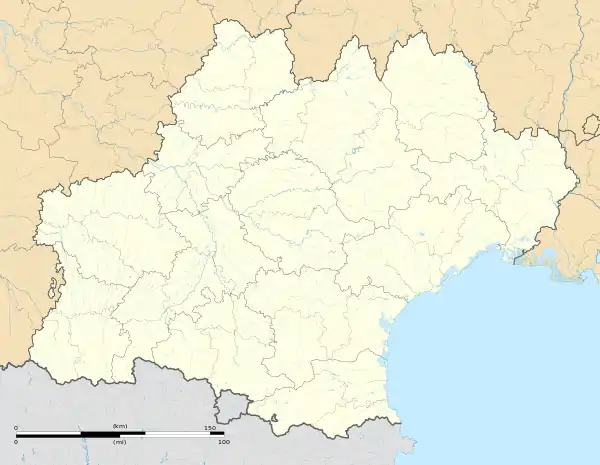Saint-Lizier | |
|---|---|
 Saint-Lizier cloister | |
 Coat of arms | |
Location of Saint-Lizier | |
 Saint-Lizier  Saint-Lizier | |
| Coordinates: 43°00′10″N 1°08′15″E / 43.0028°N 1.1375°E | |
| Country | France |
| Region | Occitania |
| Department | Ariège |
| Arrondissement | Saint-Girons |
| Canton | Portes du Couserans |
| Intercommunality | Couserans-Pyrénées |
| Government | |
| • Mayor (2020–2026) | Michel Pichan[1] |
| Area 1 | 9.01 km2 (3.48 sq mi) |
| Population | 1,377 |
| • Density | 150/km2 (400/sq mi) |
| Time zone | UTC+01:00 (CET) |
| • Summer (DST) | UTC+02:00 (CEST) |
| INSEE/Postal code | 09268 /09190 |
| Elevation | 368–578 m (1,207–1,896 ft) (avg. 484 m or 1,588 ft) |
| 1 French Land Register data, which excludes lakes, ponds, glaciers > 1 km2 (0.386 sq mi or 247 acres) and river estuaries. | |
Saint-Lizier (French pronunciation: [sɛ̃ lizje]; Occitan: Sent Líser) is a commune in the Ariège department in southwestern France, situated on the river Salat.
History
Saint-Lizier has a rich history stretching back to pre Gallo-Roman times. In 72 BC, Pompey, returning from his triumphs in Spain against Sertorius, stopped here. He gathered together the ancient tribes of the area under the name Consorani. The ramparts seen today date from 3rd century AD and enclose the oppidum.
During the fifth century, the citadel became an episcopal see, the oldest in the Ariège area. Its first bishop is thought to have been Saint Valier. The town is named in honor of its 6th Century bishop Lycerius, canonized as Saint Lizier, a bishop who participated in the Council of Agde in 506. The town has two former cathedrals: Saint-Lizier Cathedral (now the parish church) and Notre-Dame-de-la-Sède Cathedral.
Population
Inhabitants of Saint-Lizier are called Licérois.
| Year | Pop. | ±% |
|---|---|---|
| 1962 | 1,635 | — |
| 1968 | 1,695 | +3.7% |
| 1975 | 1,719 | +1.4% |
| 1982 | 1,855 | +7.9% |
| 1990 | 1,646 | −11.3% |
| 1999 | 1,592 | −3.3% |
| 2008 | 1,466 | −7.9% |
Notable person
- The mathematician Alexander Grothendieck (1928–2014) died in Saint-Lizier
See also
References
- ↑ "Répertoire national des élus: les maires" (in French). data.gouv.fr, Plateforme ouverte des données publiques françaises. 13 September 2022.
- ↑ "Populations légales 2021". The National Institute of Statistics and Economic Studies. 28 December 2023.